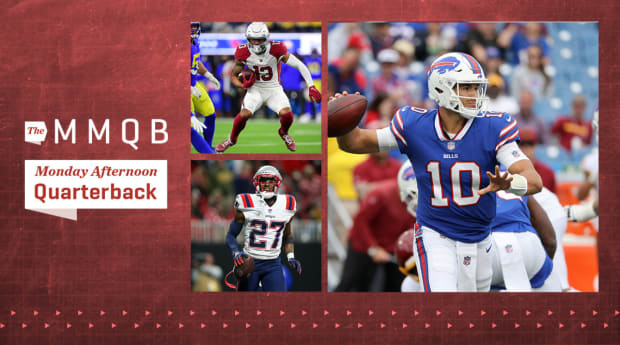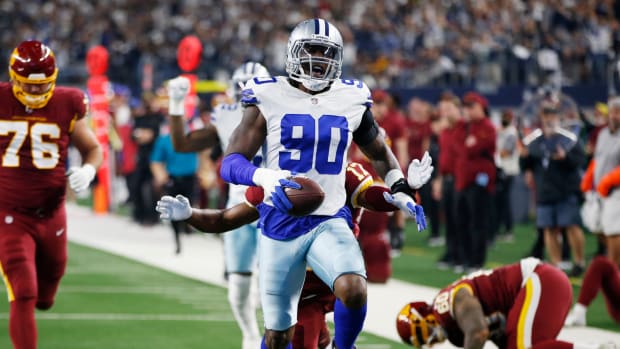A relatively average crop of free agents has started to come off the board, so in today’s MAQB, we’re going to cover some of the particulars with the bigger moves of the day.

Mitch Trubisky: Jamie Germano/USA Today Network; J.C. Jackson: Brett Davis/USA TODAY Sports; Christian Kirk: Gary A. Vasquez/USA TODAY Sports
• The Mitchell Trubisky reclamation project in Pittsburgh won’t be the first of its kind. Plenty of ex-first-round QBs have gotten second chances in new locales, and there have been high hopes for them. The truth is that it rarely actually works out that way (Steve Young, Vinny Testaverde, Trent Dilfer, Jim Harbaugh and the Steelers’ own Tommy Maddox would be notable exceptions). So what will it take for Trubisky to be an outlier?
This is going to sound overly simplistic, but it’s all about if he’s the right fit.
Trubisky’s coaches in Chicago loved him. He works his tail off and wants to be good. That said, he’s not who he was evaluated to be coming out of North Carolina—he needs a staff willing to work around some of his limitations. In Chicago, he struggled making tight-window throws in the red zone, and wasn’t great on third-and-long. The reason why is he’s not a natural dropback quarterback.
So it’ll be on Pittsburgh offensive coordinator Matt Canada to take advantage of Trubisky’s athleticism, and get him throwing on the move and off of play-action. The good news is that, for a while now, Mike Tomlin’s been talking about going to a more mobile player at the position post-Roethlisberger, and that’s really about getting the most out of Canada’s system, which is built for those kinds of quarterbacks.
Which, of course, makes it easy to see why Pittsburgh gravitated toward Trubisky, who I’m told earned a two-year deal with a base value of $14 million from the Steelers.
• Just as the trade for Carson Wentz won’t dissuade the Commanders from drafting a quarterback in the first round if the right one’s there, I certainly wouldn’t expect the presence of Trubisky to kill all interest the Steelers have in quarterbacks early in the draft. They’ve been linked to Liberty’s Malik Willis for a while (remember, it’s still ridiculously early, so take that with a grain of salt), so if he were to slip a little, it’d be interesting to see if Pittsburgh would be willing to get aggressive to go and get him.
Also, I’m sure Trubisky knows the score on this stuff, since he actually entered the league under that sort of circumstance—the Bears had just signed Mike Glennon to a big free-agent deal when they moved up to take the ex-Tar Heel starter with the No. 2 pick in 2017.
• The patience of J.C. Jackson to pass on team-friendly offers from the Patriots both last offseason and during his breakthrough 2021 campaign paid off in a very big way on Monday. His five-year, $82.5 million deal has $40 million in its first two years, with all of that money fully guaranteed, and over $54 million in its first three years. Bottom line, the part of the deal that matters most to a player, the front end, is loaded.
That said, the Chargers see the contract as one that’s reasonable compared to how the top five to seven contracts at the position set up league-wide, especially considering that Jackson made it to the open market, where some of the others were simply re-signed by their teams.
And why do they feel comfortable paying Jackson at that level? There’s the obvious stuff—he’s manned up against No. 1 receivers, he’s got off-the-charts ball production and instincts, and he’ll bring a ton of experience. There’s also a level of familiarity there.
He’s close with Derwin James, whom he’s known since high school. His new coordinator (Renaldo Hill) and position coach (Derrick Ansley) have known him for that long, too, having recruited him out of high school. Receivers coach Chris Beatty was with Jackson at Maryland.
So all the way around, this was one Tom Telesco and Brandon Staley were more than O.K. moving forward on with conviction.
• Christian Kirk’s big contract in Jacksonville raised plenty of eyebrows across the league, and the money there is real (though not quite at the $21 million-per-year level). He gets $20 million to sign, a $1.5 million base this year, and a $16.5 million base next year, plus $500,000 workout and per-game roster bonuses in each year. Add it up, and he’s on track to make $22.5 million in Year 1 and $39 million over the first two years, and that’s before you get to the $3 million in upside (tied to catches and yards) tucked into each year of the deal.
The question then is … why?
I can come up with two reasons. One, Kirk’s versatility, and proficiency with the ball in his hands, will allow for Doug Pederson and Jaguars offensive coordinator Press Taylor to be creative in how they use him not just in the pass game, but jet sweeps and even out of the backfield. Two, because of the Jaguars’ history, they have had to pay a bit of a tax on free agents.
What’s his real value? Most teams thought he’d get to $14 million or maybe $15 million per year. Which means it’s an overpay for a guy who’s never had a 1,000-yard year. But maybe not as drastic of one as it might seem on the surface—teams are indeed looking for speedy slots like Kirk. And if you dig around a little, you’ll find too that Kirk’s position coach has told people that he was the team’s best, most consistent receiver last year.
So the Jags are getting a good player, albeit one they overpaid for.
• The Browns’ decision to trade for Amari Cooper does take on new context now with Kirk getting what he did. Cooper’s under contract for the next three years, with a nonguaranteed $20 million base in each season. So for a similar rate, Cleveland’s getting a guy who’s been more productive, even if he is two years older, and with the flexibility to move on whenever they want to.
And again, they get that for a fifth-rounder, and moving their sixth-rounder down 10 spots.

Tim Heitman/USA TODAY Sports
• The other side of that trade? The Cowboys playing the positional-value game. Where it didn’t take long for Dallas to decide it could live with a younger player (Michael Gallup) on a cheaper deal at receiver, they worked really hard to keep their best edge rusher.
They got that accomplished late Monday by doing a reworked three-year deal with DeMarcus Lawrence that included $30 million in guaranteed money. The truth here? It’s harder to find a good pass rusher than it is a receiver, so you stick with guys who’ve produced for you at the former spot. (That’s also a big reason why they’ve stood by Randy Gregory through a lot of ups and downs.)
• The two other things to remember with the Jaguars’ Monday splurge—which also included linebacker Foye Oluokun, defensive tackle Foley Fatukasi, guard Brandon Scherff and tight end Evan Engram—are that they have Trevor Lawrence on a rookie deal for two more years and their drafts at the end of the last decade are what cleared space for all this—both with misses and players like Leonard Fournette and Jalen Ramsey who forced their way out.
Also, the way the money was spread around into different areas probably reflects just how wide-ranging the Jaguars’ needs are in Pederson’s first year.
• The Bengals’ focus going into free agency was right where you’d expect—fixing what’s in front of Joe Burrow. And their plan for Day 1 was to land a heady guard and a heady center that could improve the team’s pass protection on the interior of the offensive line. Plan A involved Bucs center Ryan Jensen, but Jensen quickly re-signed with Tampa after the Tom Brady news broke on Sunday night.
So Cincinnati pivoted and focused on guards first, with Jensen’s teammate Alex Cappa, Laken Tomlinson and Austin Corbett all viewed as upgrades to what they rolled out there at the position last year—quickly landing on Cappa on Monday shortly after noon at about $8.75 million per year. And they moved to go get Patriots free-agent Ted Karras to fill center hole at $6 million, knowing he’s got flexibility to play guard, too.
That represents a pretty good start for Cincinnati in taking care of the franchise’s protection.
• Give Buffalo credit for aggressively taking care of its offensive line, too, to protect their own young star quarterback. Getting Mitch Morse extended was important, and getting Rodger Saffold in the fold to replace Jon Feliciano, while clearing the way for promising tackle Spencer Brown to take Daryl Williams’s spot on the right side, showed they came in with a comprehensive plan.
Bottom line, Morse is valuable to Josh Allen for a number of reasons, and Saffold and Brown should wind up being upgrades.
• Good for Haason Reddick, scoring a three-year, $45 million deal. Everyone knew he was a good player coming out of Temple, but his sawed-off build had most project him to play an off-ball linebacker spot. Eventually, he found his way back to the edge, where he played in college, broke out there in 2020, his final year in Arizona, and then backed up that up with another big year last fall playing for his college coach in Carolina.
There’s a good lesson for all players in there, that sometimes it can take a while for a really talented guy to find his best fit as a pro.







